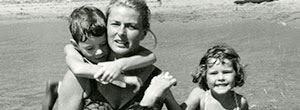Film: “Ingrid Bergman — In Her Own Words”
When director Stig Björkman met Isabella Rossellini in 2011, she suggested they “make a film about Mama.” “Ingrid Bergman — In Her Own Words,” evolved into as much a tribute to the inspired actress for fans such as myself, but also insight into how and why the role of actress consistently surpassed any other role in Bergman’s life, including mother and wife. Yes, Ingrid was “in love” with her lovers and with her husbands and even with her children, but first and foremost she was in love with being filmed because it continued for her the role of her beloved child by her photographer father, who died when she was 13. The camera took his place. As director, Alfred Hitchcock, put it, “She “took the films more seriously than life,”

The film, in fact, begins with a reading of her diary from 1929, the sorrowful year in which Ingrid’s loving father passed away (her mother died when Ingrid was three). This was followed by the death of other close friends and family with whom she then lived. And so Ingrid turned to the camera in place of a family from then on, both behind it and also in front of it. There are seems to be as many images of Ingrid with a camera in her hand as there are of her being filmed.
The private life of the actress is shown through previously unseen private footage, lifelong diaries, notes, letters, lots of home movies and interviews with her children. Bergman was, as the film notes, “ one of those people who never threw anything away,” keeping trunks full of this documentation no matter how many times she moved residences — in Sweden, Hollywood, Italy, France, London. Being able to make herself a home and at home while turning in stellar performances in three countries with three different cultures and languages, is also testament to the talents of this multi-lingual actress.
Bergman’s children provide informal on-camera interviews, filled with intelligence and awareness. Their overall view was that she was wonderful, “exuberant” company and they could not get enough of it, though she was away so much of the time. The actress rationalized this “nontraditional” mothering, saying she’d “rather be a friend than someone who tells them to brush their teeth,” and they all report how much they loved her in spite of her free spirit ways. Daughter Pia sums up the opinion of all the children, “She was so amusing and fun. We just wanted to see more of her.” Yet this was not a Judy Garland story of a struggle to provide as a mother. Ingrid was “madly in love” with each film, each husband, and just about each movie director with whom she was working “at the time.” She just grew restless and moved on after each event, as she had from the beginning.
Bergman was already an established star in Swedish films when “Gone With the Wind” producer David O. Selznick hired her for a Hollywood remake of one of her domestic hits, “Intermezzo.” Just as her father naturally chose to film his one daughter, so filmmakers in Sweden had chosen her as a teen-ager and made her into a star. The “no make-up” screen tests that Bergman made for Selznick show her as the ideal image of statuesque Scandinavian health; she is absolutely luminous. Clips from her iconic films serve reminders of why this captivating, natural actress was a seven-time Academy Award nominee and three time Academy Award winner. Remarkably, her earlier films are the most riveting (Gaslight, Casablanca, Notorious), in which she appears so straightforward, and vulnerable, and yet all the while just a little mischievous and lively.
This is also how Ingrid appears in all of the family “home” movies, which are confined to the backyard of her Beverly Hills home when she brought first husband and Pia there, the secluded villa in Italy when she was involved with movie director, Roberto Rossellini, and on the private island owned by her third producer husband in Sweden, when she married for the third time.
In several of the interviews, first daughter Pia ruefully traces the family history that soon put distance between mother and daughter as she grew up (in Los Angeles), unlike her half siblings, Roberto, Isabella, and Ingrid in Italy. Yet, while Pia perceived life as happier for the three siblings who she joined on occasion, film footage also shows them sequestered them to a remote Italian village to avoid the public.
Meanwhile Bergman loved making films as much as her audience loved watching them. She mentions throughout her career in her diary how “delighted” she is to be working with Humphrey Bogart and Cary Grant. She often writes in her letters, “It is everything I’ve always wanted. It’s incredible when your dreams come true.”
Bergman had just as quickly became “the ideal of American womanhood” and a contender for Hollywood’s greatest leading actress as she had been plucked for films as a teen. David O. Selznick once called her “the most completely conscientious actress” he had ever worked with. In 2007, the American Film Institute ranked ranked Bergman fourth-greatest female actress of classic American cinema. Bergman won three Academy Awards, , placing her in a tie for second place in the number of Oscars won.
Yet, as Ingrid Bergman became a Hollywood legend, she also became one of first major victims of the paparazzi, even before the term itself would be coined later in Le Dolce Vita. Because of her straightforward, naïve nature, Bergman became as “notorious” as the name of her celebrated film when she not only had a child out of wedlock, but both she and the father were married to other people. This came about after she wrote an admiring letter to Roberta Rossellini, and he brought her to Italy to make a film. The affair was so scandalous that Bergman was essentially barred from returning to Hollywood. One film scene shows Ed Sullivan, the New York columnist and host of one of the most popular TV shows at the time, asking the audience what they thought about her appearing on his stage.
When Rossellini turned out to be as much of a free spirit as she, subsequently engaging in an affair in 1956 with another actress and having another child out of wedlock, Ingrid married for the third time to a Swedish producer, Lars Schmidt, and was so pleased that he had a small island that served as a family retreat. And again, the family footage of the three or four children, now teens, is contained to frolicking at the beach and little else.
Eventually, after living and working in France, Bergman returned to Hollywood, redemption achieved, to star in “Anastasia” which earned her another Oscar. Friend and Notorious co-star, Cary Grant, graciously accepted her first oscar at the Academy Awards when she was out of the country during the Rossellini scandal. In her words, “I went from angel to whore and back again.” She worked film, stage and later television up until her death in 1982 on her 67th birthday from cancer.
Exclusive Engagement Landmark’s Nuart Theatre through Dec. 19, 11272 Santa Monica Boulevard just west of the 405 Freeway, (310) 473-8530, “Ingrid Bergman – In Her Own Words” is 114 minutes and Not Rated and opens As an added attraction, the Nuart is screening midnight shows of “Casablanca.”

